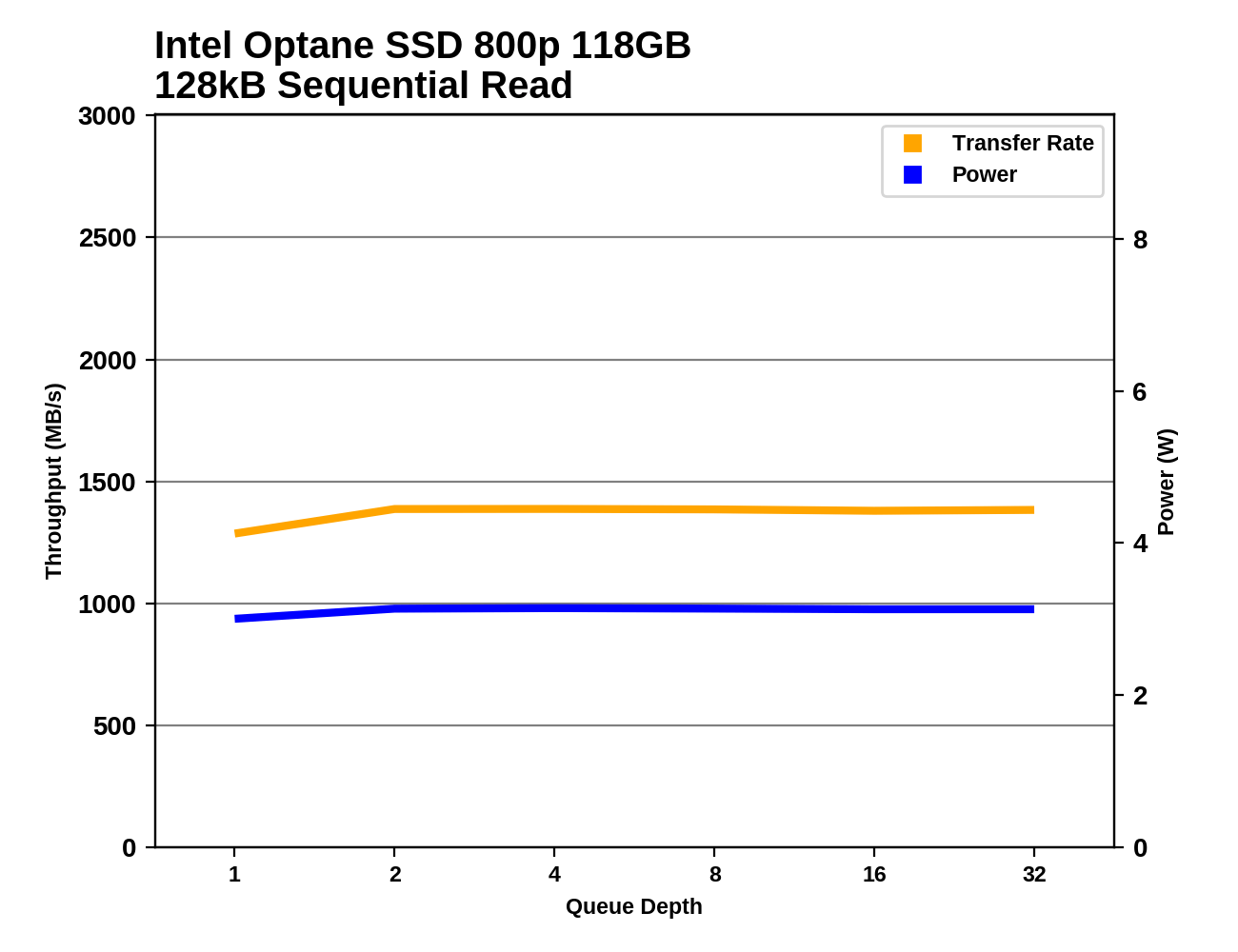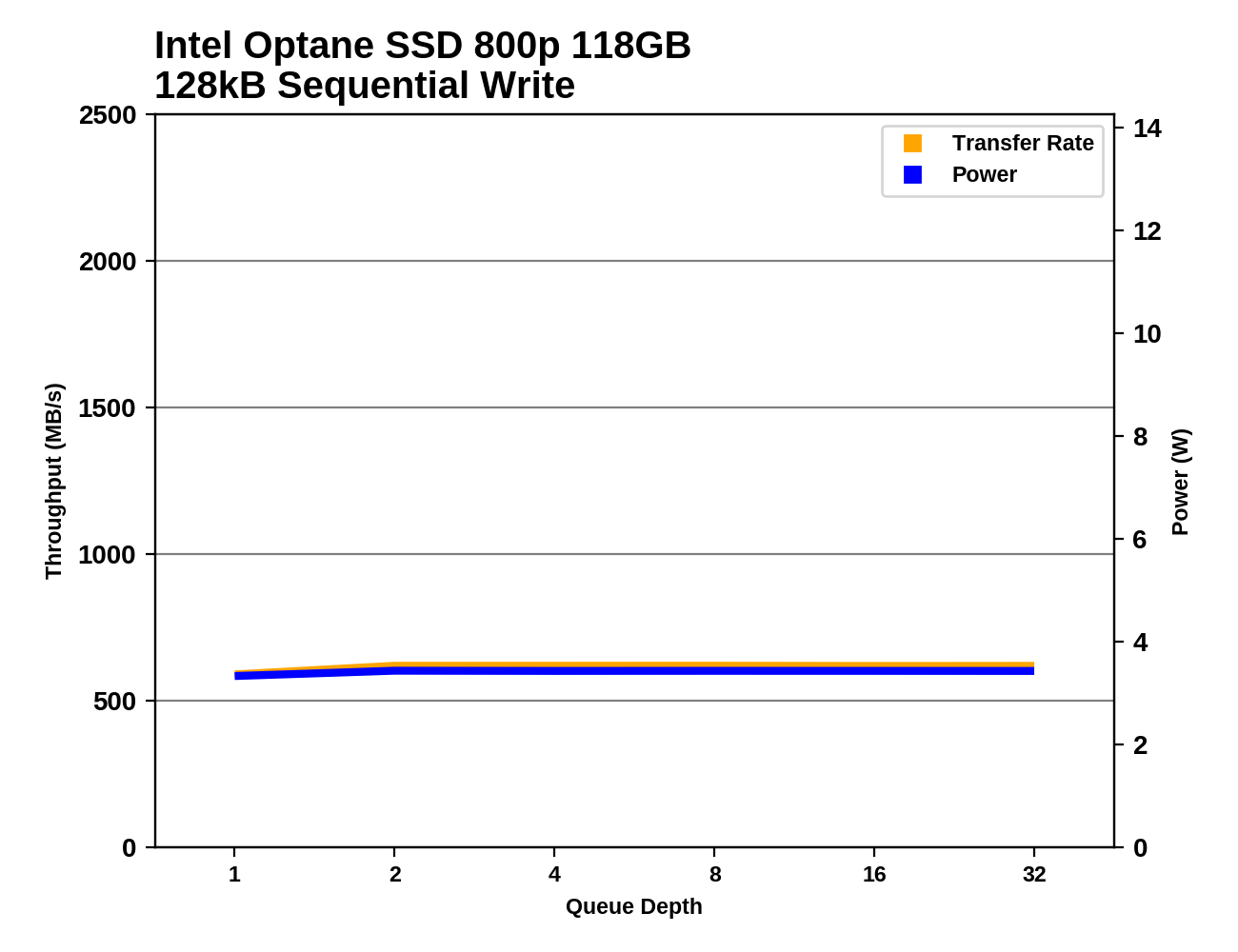The Intel Optane SSD 800p (58GB & 118GB) Review: Almost The Right Size
by Billy Tallis on March 8, 2018 5:15 PM ESTSequential Read Performance
Our first test of sequential read performance uses short bursts of 128MB, issued as 128kB operations with no queuing. The test averages performance across eight bursts for a total of 1GB of data transferred from a drive containing 16GB of data. Between each burst the drive is given enough idle time to keep the overall duty cycle at 20%.

The QD1 burst sequential read performance of the Intel Optane SSD 800p is close to their rated maximum throughput, but they are far behind the 900p and high-end Samsung drives that actually need more than two PCIe lanes.
Our test of sustained sequential reads uses queue depths from 1 to 32, with the performance and power scores computed as the average of QD1, QD2 and QD4. Each queue depth is tested for up to one minute or 32GB transferred, from a drive containing 64GB of data.

On the longer sequential read test, the Samsung NVMe SSDs fall down to the level of the Optane SSD 800p, because the flash-based SSDs are slowed down by some of the data fragmentation left over from the random write test. The Optane SSDs performed those writes as in-place modifications and thus didn't incur any fragmentation. This leaves the Samsung 960 PRO 2TB barely faster than the 800p, while the 900p runs away with its lead.

The Optane SSD 800p has the clear lead in power efficiency, as its second-tier performance comes with far lower power consumption than the top-performing 900p.
 |
|||||||||
There are no big surprises with the queue depth scaling; the 800p's sequential reads are slightly faster at QD2 than QD1, but there's no further improvement beyond that. The 800p is easily staying within its 3.75 W rated maximum power draw.
Sequential Write Performance
Our test of sequential write burst performance is structured identically to the sequential read burst performance test save for the direction of the data transfer. Each burst writes 128MB as 128kB operations issued at QD1, for a total of 1GB of data written to a drive containing 16GB of data.

The burst sequential write speed of the Intel Optane SSD 800p is no better than the low-end flash-based NVMe SSDs. Without any write caching mechanism in the controller, the fundamental nature of 3D XPoint write speeds shows through. The 900p overcomes this by using a 7-channel controller, but that design doesn't fit within the M.2 form factor.
Our test of sustained sequential writes is structured identically to our sustained sequential read test, save for the direction of the data transfers. Queue depths range from 1 to 32 and each queue depth is tested for up to one minute or 32GB, followed by up to one minute of idle time for the drive to cool off and perform garbage collection. The test is confined to a 64GB span of the drive.

The Optane SSD 800p looks better on the sustained sequential write test, as all the TLC-based SSDs run out of SLC cache and slow down dramatically, while the Optane SSDs keep delivering the exact same performance.

Despite their very different sequential write throughput, the Optane SSD 900p and 800p end up with very similar power efficiency on this test. The Samsung NVMe drives are even more efficient, but only the premium MLC-based 960 PRO has a large lead.
 |
|||||||||
Almost all of the drives show no performance scaling with increasing queue depth, as large-block sequential writes can keep all the memory channels busy with only a little bit of buffering. The 900p needs at least two 128kB writes in flight to reach full throughput.










116 Comments
View All Comments
Hurr Durr - Thursday, March 8, 2018 - link
Hypetane!iter - Thursday, March 8, 2018 - link
optane = hypetanex-point = xtra-pointless
It keeps getting worse and worse instead of getting better. The next x-point iteration may slip below nand even in the few strong points of the technology.
Also, it doesn't seem that enterprise is very interested in intel's offering, seeing how they struggle to cram the product in market niches where it is xtra-pointless, I'd go on a limb and assume that's not because of love for consumers or skipping on them fat enterprise product margins.
Also, it seems that intel gave very misleading information not only in terms of performance, but also regarding the origin of the technology. The official story is its development began in 2012 as a joint venture between intel and micron.
That however is not true, x-point can be traced back to a now erased from history company named Unity Semiconductors, which was flogging the tech back in 2009 under the CMOx moniker.
Courtesy of archive.org, there is still some trace of that, along with several PDFs explaining the operational principle of what intel has been highly secretive about:
https://web.archive.org/web/20120205085357/http://...
All in all, the secrecy might have to do with intel's inability to deliver on the highly ambitious expectations of the actual designers of the tech. It is nowhere near the 200% better than nand density, in fact it seems at the current manufacturing node it won't be possible to make more than 256 gb in m2 form factor, which is 8 times less than mlc nand or 24 times less than what was projected in 2009. Performance is not all that stellar too, a tad lower than what slc was capable at back in 2012, thank the gods nobody makes slc anymore, so there's a ray of sun to make xtra-pointless hypetane look good on paper.
chrnochime - Thursday, March 8, 2018 - link
Rambus renamed it to ReRAM according to this article in 2015, so it would seem the tech lived on through Rambus after the aquisition of Unity Semi.https://www.eetimes.com/document.asp?doc_id=132552...
But I'm not sure if it's the exact same tech as Intel's.
iter - Thursday, March 8, 2018 - link
Check the PDFs, what little intel posted about it is all there. They may have licensed the tech from rambus. It is not like rambus does anything other than patent milking anyway.iter - Thursday, March 8, 2018 - link
"Coincidentally", rambus bought unity in 2012, exactly when intel allegedly started developing...MDD1963 - Friday, March 23, 2018 - link
Not everyone remembers a few sticks of RAMBUS RDIMMS for some Pentium 3 boards costing $500-$600 a stick back in '99-'00....; and being outperformed by DDR. Nice job, RAMBUS!tommo1982 - Thursday, March 8, 2018 - link
Am I reading it right? Was Cross-point memory supposed to be cheaper than NAND?WinterCharm - Thursday, March 8, 2018 - link
Yes. But I guess we won't see that for a while.Latency and power consumption are great... but speed and capacity leave a lot to be desired. When MacBook Pros have NVME drives capable of 3.2 GB/s (yes gigabytes) at a 2TB capacity... Optane is far behind.
There are some advantages, but I expect that Intel will need to do a lot more work before these are cheaper, faster, and have higher capacity.
Reflex - Friday, March 9, 2018 - link
That said, latency is what users notice. Max speed is a rarely encountered scenario in most user workloads.iter - Saturday, March 10, 2018 - link
No human notices microseconds. Delay becomes noticeable at about 10-20 msec, depending on the individual's reflexes, becomes annoying at about 50 msecs, and becomes detrimental at 200+.10 mseconds is 10000 microseconds. Hypetane improves things in the double digit microseconds range. Humans cannot notice that, not today, not in a million years.